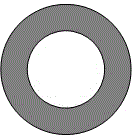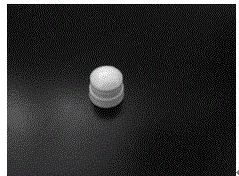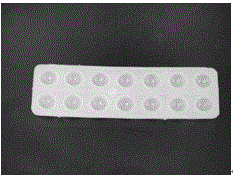Preparation method of medicine-carrying soft corneal contact lens
A technology for soft corneas and contact lenses, applied in glasses/goggles, instruments, optics, etc., can solve the problems of low bioavailability, short drug release cycle, and decreased light transmittance, and achieve strong and stable light transmittance release effect
- Summary
- Abstract
- Description
- Claims
- Application Information
AI Technical Summary
Problems solved by technology
Method used
Image
Examples
Embodiment 1
[0034] Dissolve β-hydroxyethyl methacrylate prepolymer, ethylene glycol methacrylate, azobisisobutyronitrile and diclofenac sodium in methanol, stir evenly, and apply the slurry on such as figure 1 on the gray area of the round hole of the plate shown, which is then transfer printed onto a figure 2 The surface of the male mold shown is then placed in an oven at 120°C and cured for 60 minutes; repeat the above operations to obtain different layers of the drug film;
[0035] After mixing β-ethyl methacrylate, methacrylic acid, N-vinylpyrrolidone, ethylene glycol methacrylate and azobisisobutyronitrile evenly, pipette the above mixed solution and place it in figure 2 Then insert the male mold printed with the drug film into the female mold, place it in an oven at 90°C, and turn it into pieces after curing for 45 minutes to obtain the drug-loaded soft corneal contact mirror.
Embodiment 2
[0037] Add β-hydroxyethyl methacrylate prepolymer, ethylene glycol methacrylate, azobisisobutyronitrile and drugs to the solvent in sequence, and after stirring evenly, apply the resulting solution on a plate with round holes , forming a circular ring, and then transfer printing it to the upper surface of the positive mold, and then heat and cure it in an oven; repeat the above operations to obtain different layers of the drug film;
[0038] After mixing β-hydroxyethyl methacrylate, methacrylic acid, N-vinylpyrrolidone, ethylene glycol methacrylate and azobisisobutyronitrile evenly, pipette the above mixed solution and place it in the female mold. Then embed the upper surface of the male mold printed with the drug film obtained in step S1 into the concave surface of the female mold, put it in an oven for curing, and turn it into pieces to obtain the drug-loaded soft corneal contact mirror,
[0039] The male mold is a cylinder, and the upper surface of the cylinder...
Embodiment 3
[0050] In vitro release test: Soak the dry medicated lens of the drug-loaded soft contact lens obtained in Example 2 in 3ml of deionized water for 2 days to eliminate residual unreacted monomers, and then transfer to 3ml of fresh normal saline and placed in an air shaker at 37°C to release the drug by shaking, and the release liquid was replaced with fresh physiological saline at regular intervals every day, and the obtained release sample liquid was determined by HPLC method.
[0051] Figure 4 According to the method of Example 3, the concentration of the release sample solution obtained after the in vitro release test of the drug-loaded soft contact lens obtained in Example 2 is a graph showing the change in the number of days. It can be seen from the graph that the drug release cycle is long. , the sustained-release effect is stable, and since the central light-transmitting area is not modified and drug-coated during the drug release process, the transparency of the light-...
PUM
 Login to View More
Login to View More Abstract
Description
Claims
Application Information
 Login to View More
Login to View More - R&D
- Intellectual Property
- Life Sciences
- Materials
- Tech Scout
- Unparalleled Data Quality
- Higher Quality Content
- 60% Fewer Hallucinations
Browse by: Latest US Patents, China's latest patents, Technical Efficacy Thesaurus, Application Domain, Technology Topic, Popular Technical Reports.
© 2025 PatSnap. All rights reserved.Legal|Privacy policy|Modern Slavery Act Transparency Statement|Sitemap|About US| Contact US: help@patsnap.com



